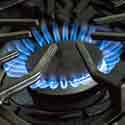Unpredictable gas pressure in WW2: effects on meals and stress

Unpredictable gas supplies added to the problems of WW2 rationing and the years of increasing austerity afterwards. Unlike the power cuts from electricity, there were no gas power cuts, but – and it was a big BUT - the gas pressure was just lowered unpredictably, often to almost nothing. This page explains why, and goes on to describe the often unpalatable effects on meals cooked in gas ovens and the stress on the women who needed to produce cooked meals for the family.
____
By the webmaster based on personal childhood recollections and discussions with older people
Why no gas power cuts - just unpredictable supply
Power cuts were normal at the time of war because power was needed for the war effort. Buildings would suddenly be plunged into darkness, street lights would go out and electric fires would go off - all without warning. These power cuts were from electricity. But gas supplies were never cut off completely. So there were no gas power cuts. Gas pressure was simply progressively and unpredictably lowered to almost, but not quite, nothing - just enough to keep a tiny flame alight.
The reason gas was never cut off completely was because of the potential danger. If it were to happen while a gas jet was lit and therefore open, the flame would go out. Then when the gas came on again at some unpredictable time, it wouldn't get lit and would escape into the surroundings. This could be very dangerous.
One reason was that the gas, being coal gas, was poisonous, and people could die from inhaling it.
The other reason was the risk was of explosion. If a lot of gas escaped into a confined space and came in contract with a naked flame, there would be an explosion. At the time, naked flames were not uncommon. For example, someone would unknowingly light up a cigarette or pipe, and smoking was not just common, it was normal.
So, to avoid these risks, the gas supply was never completely shut off, just lowered without warning.
Cooking with unpredictable gas supplies
Most modern housing estates had gas cookers, and cooking with unpredictable gas pressure was extremely stressful because ovens couldn't get up to temperature and hobs took ages to heat kettles and saucepans. Incidentally, cooking on the older-styled coal-fired range did not have the same problems because the temperature was under residents' control because - within the limitations of coal rationing - they could always put more coal on the fire for cooking and use less at other times.
Baking cakes and pies were often spoilt during cooking when gas ovens couldn't get up to temperature or lost temperature too quickly. This was all the more upsetting and irritating because the ingredients couldn't be replaced because of food rationing.
My grandmother once had to rescue our Sunday roast by taking the meat out of the oven and putting it into a saucepan of water to boil it. The result was a delayed meal and a bland taste.
Government requests to cope with low gas pressure
contributed by Peter Johnson, recollections
To save gas, we were asked to cook using coal where possible, as many houses still had their old-style kitchen fires or kitchen ranges. Sometimes the gas pressure was so low that it was quicker to boil a kettle on the coal fire anyway.
My mother often put a large biscuit tin into the grate of a coal fire and piled the hot coal up around it, which made a makeshift oven.
In our house, making toast was always done with a special long-handled toasting fork on the coal fire.
Household gas - poison
As previously mentioned, the danger of gas supply being cut off completely would have been gas filling a room when it came on again - and household gas, being coal gas, was poisonous. 'Putting one's head in the gas oven' without lighting the gas seemed to be the most common suicide method. During the war, I often heard people saying that they felt like doing it, although I don't think I knew anyone who actually did it. When ovens were converted to natural gas, this particular suicide method was no longer an option because natural gas is not poisonous.
| sources | webmaster | contact |
Text and images are copyright
If you can add anything to this page or provide a photo, please contact me.



